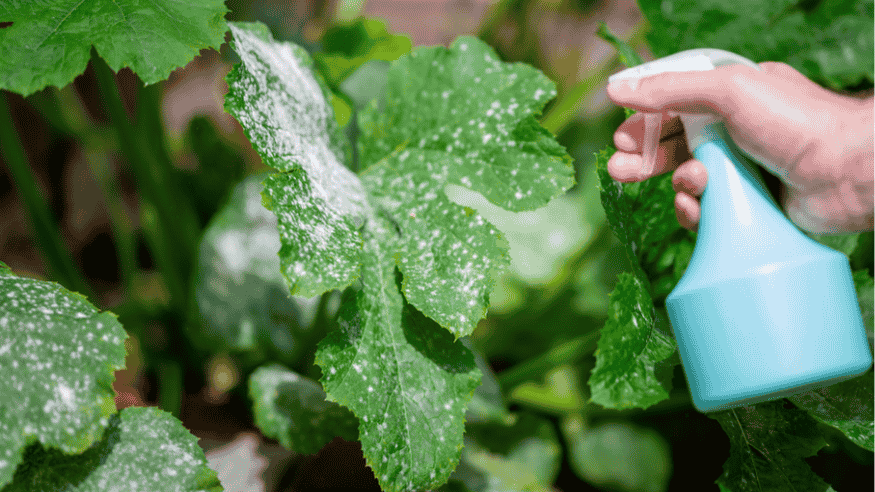
Powdery Mildew Treatment for Cucumbers, Tomatoes, and Brinjal Plants
Share
For hard-working farmers, nothing can be more disheartening than seeing the leaves of their cucumbers, tomatoes, and brinjal plants covered in a white, powdery layer.
This occurs due to a common fungal disease, powdery mildew on plants. This disease spreads quickly in fruit and vegetable plants, weakens their growth, and reduces both yield and quality. If left unchecked, it can ruin entire crops, making early prevention and management crucial for sustainable farming.
Thankfully, several effective powdery mildew treatment methods exist today.
From natural remedies to organic solutions, farmers and gardeners now have access to safe and more reliable approaches to keep their crops healthy. These methods not only protect your plants from fungal diseases but also restore their vitality.
By focusing on sustainable techniques, you can save your harvest while avoiding harmful chemicals that may damage the soil or environment.
In this blog, we’re going to explore the best treatments for powdery mildew, including fungicide for plants. Farmers can use these methods to safeguard their cucumbers, tomatoes, and brinjal plants, ensuring they remain lush, green, and healthy.
Why Powdery Mildew Treatment is Essential
Powdery Mildew is one of the most widespread fungal diseases affecting a wide range of crops, including cucumbers, tomatoes, and brinjal plants. This disease spreads rapidly and causes significant damage to plant leaves, hindering the growth of plants. Without timely powdery mildew treatment, this disease becomes severe.
When left untreated, this disease damages plant leaves, reduces photosynthesis rate, weakens plant defenses, and often leads to secondary infections. To avoid this, implementing strong powdery mildew control measures is necessary. By doing so, farmers can minimize risks and safeguard their plants against fungal diseases.
Effective Methods for Powdery Mildew Treatment in Plants
Managing powdery mildew on plants requires a combination of preventive and curative methods that are both effective and sustainable. For farmers cultivating cucumbers, tomatoes, and brinjal, controlling this fungal disease is vital to prevent crop stress, protect yields, and ensure healthy production of fruits and vegetables.
Here are some proven powdery mildew treatment methods that farmers can implement to safeguard their valuable plants:
Organic Fungicide for Plants
Using an organic fungicide for plants is one of the most reliable and eco-friendly approaches to suppress powdery mildew. These solutions not only target fungal spores but also ensure residue-free produce, aligning with modern consumer demands. They are highly effective when integrated with preventive measures.
Milk Spray
Milk spray has shown promising results in reducing mildew growth due to its natural antifungal properties. Diluted milk solutions (1 part milk and 9 parts water), when applied regularly, create an unfavorable environment for fungal development. Milk spray is a cost-effective, safe, and easily accessible option to treat this disease.
Bacillus Subtilis
The use of Bacillus subtilis, a beneficial bacterium, is gaining popularity for powdery mildew control. It works by colonizing plant surfaces and outcompeting the fungi responsible for powdery mildew. This biological approach not only enhances plant protection but also reduces the need for chemical fungicides in farming.
Baking Soda Solution
A simple yet powerful method for powdery mildew treatment involves the use of baking soda. Its alkaline nature disrupts fungal growth, making it effective for early-stage infections. To prepare this solution, mix 1 tablespoon of baking soda with 3 litres of water. Add a few drops of liquid soap to make the solution sticky.
Neem Oil
Neem oil acts as a natural fungicide. Regular applications form a protective coating on plant surfaces, limiting fungal spread. Mix 2 to 3 tablespoons of neem oil with 3 litres of water to prepare an effective neem oil solution. Spray this solution on your plants every 7 to 10 days, covering both the upper and lower surfaces of the leaves.
Resistant Plant Varieties
Using resistant plant varieties is one of the most effective long-term solutions for powdery mildew on plants. A wide range of cucumber, tomato, and brinjal varieties are available that show improved resistance to powdery mildew. These varieties are largely used in commercial farming to reduce input costs and minimize losses.
Sulfur-Based Treatments
Sulfur has been used for decades as one of the best fungicide for powdery mildew. It prevents fungal spores from germinating and spreading across crops. For farmers, sulfur-based products provide consistent results, though application should be carefully timed to avoid plant stress in hot conditions (temperatures above 32°C).
Garlic Extract
Garlic extract is a natural remedy with strong antifungal properties. It contains an active compound, allicin, which prevents the germination of powdery mildew spores. An effective garlic extract for treating powdery mildew can be prepared by blending two whole bulbs of fresh garlic in 4 cups of water with a few drops of liquid soap.
Compost Tea
Applying compost tea enriches soil microbiology and strengthens plant immunity against diseases. By boosting beneficial microorganisms, compost tea improves plant resilience and helps in suppressing powdery mildew. This method also enhances soil fertility and offers a safer alternative to chemical fungicide for plants.
Oils and Anti-Transpirants
The use of horticultural oils and fungicide for plants with anti-transpirant properties helps create a protective layer on leaves. This barrier reduces humidity levels around foliage, making conditions unfavorable for fungal development. Farmers adopting this method benefit from both disease control and improved plant stress tolerance.
Pruning and Sanitation
Regular pruning and strict sanitation are fundamental in minimizing the spread of powdery mildew. By removing infected leaves and improving airflow between plants, farmers can reduce humidity levels that favor fungal growth. Disposing of infected plants properly ensures the fungus does not reinfect future crops.
Vinegar Spray
A diluted vinegar solution acts as a natural antifungal spray that can help suppress powdery mildew on plants. Its acidity creates an environment where fungal spores cannot survive, making it an affordable and accessible option for farmers. Regular applications, when carefully measured, can support sustainable crop protection.
Get Rid of Powdery Mildew Easily with Octa Organics
Effective powdery mildew treatment is crucial for protecting economically important crops like cucumbers, tomatoes, and brinjal. From biological solutions to natural sprays, farmers now have multiple ways to combat this disease while ensuring better yields, reducing dependency on chemicals, and promoting long-term plant health.
For farmers seeking more reliable and eco-friendly solutions, Octa Organics offers an effective organic fungicide designed to control powdery mildew and other fungal diseases organically. Choosing our products means securing your crops with natural treatments while maximizing profitability and supporting sustainable farming.

